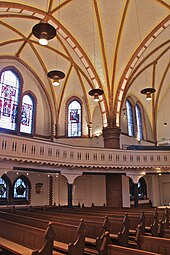Kreuzkirche (Hamburg-Wandsbek)
The Evangelical Lutheran Kreuzkirche in Hamburg-Wandsbek is located on Kedenburgstrasse in the immediate vicinity of Eichtalpark and directly on the banks of the Wandse .
Building the church
The strong population growth of Wandsbek due to industrialization in the second half of the 19th century also changed the village of Hinschenfelde, on whose former area the Kreuzkirche stands. As early as 1893, a small church was built on Walddörfer Strasse , which initially belonged to the Stormarn provost and was looked after by the Alt-Rahlstedt church . After Hinschenfelde came to Wandsbek in 1900, the church was assigned to the parish of the Christ Church in Wandsbek in 1904. The construction of a second church in what was then east of Wandsbek was already being planned at that time.
In November 1907, the construction plans of the architect Fernando Lorenzen were accepted, the foundation stone was laid on December 6, 1908 and the topping-out ceremony took place on October 23, 1909. The church was consecrated on September 25, 1910. The church is a typical, conventional neo-Gothic building, the floor plan of which is a Greek cross with short arms and a dominant crossing with a star vault . The outer facades are made of rustic hand-painted bricks with white joints and show the first beginnings of the reform movements in church building before the First World War . Today the church has 458 seats, the gallery another 156.
The 58 m high tower has a gold-plated cock .
Interior
The interior has a very strong central character due to the crossing vault, which is reinforced by a surrounding wooden gallery.
There was an abundance of foundations to decorate the church, mainly from the Wandsbek-based companies. The largest were certainly the organ and tower clock, but the altar, pulpit, baptismal font and window were also financed to a considerable extent by donations.
The pulpit and altar are made of oak and carved. The pulpit is dominated by symbols of Christ, the altar is dominated by the symbols of bread and wine . Carved figures of the apostles Peter and Paul stand under the cross on the altar wall . For the altar, the church received a leather-bound, iron-clad Bible with a dedication from Empress Auguste Viktoria . The christening block is a foundation of the Neubert nursery and was therefore decorated with floral motifs.
window
The interior design of the church with stained glass windows was dominated by the five clover-leaf windows in the apse with fifteen individual depictions, all of which were damaged or destroyed in bombing raids in 1943 . There were new stained glass windows for the transepts during the renovation in 1954, and the openings in the clover leaf windows in the chancel were bricked up. It was not reopened until another renovation in 1975 and modern windows were designed by the artist Hans Kock . Remains of nine of the original windows were rediscovered in the basement of the church in 1994, restored and installed under the side galleries as attachment windows. These windows remained fragments whose imperfection is supposed to remind of the destruction of the war .
Changes after 1945
During the first extensive renovation of the church in 1954, the dark-looking walls were given a light color and the formerly free-standing pulpit was attached to the south wall.
Bells and tower clock
Since the church was built, there have been three steel bells from the Bochumer Verein foundry in the tower . The smallest bell bears the inscription Jauchzet the Lord all the world! who have favourited Middle Serve the Lord with joy! and the greatest comes before him with exultation!
Two of the bells also serve as quarter-strike and hour-strike bells for the tower clock, which is one of the few Hamburg tower clocks that still works completely mechanically and is wound by weights. There is a dial made of sheet copper on three sides of the tower. All the dials and the clock were donated by the Wandsbeker leather factory Luetkens.
organ
The first organ from the Röver organ workshop was a gift from the largest company in Wandsbeck at the time, the Reichardt cocoa and chocolate factory .
The instrument was slightly rebuilt several times and replaced in 1963 by a new one from Emanuel Kemper & Sohn , for which, however, many materials from the first organ could be used. His disposition is:
|
|
|
|
||||||||||||||||||||||||||||||||||||||||||||||||||||||||||||||||||||||||||||||||||||||||||||||||||||||||||||||||||||||||||||
- Coupling: I / II, I / III, I / P, II / P, III / P
- Playing aids: 3 free combinations, 2 free pedal combinations, tutti
Photographs and map
Coordinates: 53 ° 34 ′ 45.7 " N , 10 ° 5 ′ 12.3" E
literature
- Ralf Lange: Architecture in Hamburg . Junius Verlag , Hamburg 2008, ISBN 978-3-88506-586-9 , p. 197 f .
- Helmuth Fricke, Michael Pommerening, Richard Hölck: The churches on the Wandsbeker market . Mühlenbek-Verlag, Hamburg 2002, ISBN 3-9807460-2-X , p. 106-108 .
Individual evidence
Web links
- Homepage of the community
- List of recognized monuments of the city of Hamburg ( Memento from November 5, 2012 in the Internet Archive )
- The history of the church on the website of the congregation ( Memento from August 15, 2014 in the Internet Archive )









